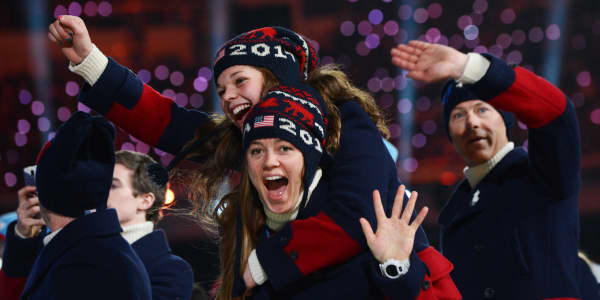Dressing Olympic athletes for success
When the opening ceremonies kicked off at the Sochi Winter Olympics, top athletes were able to strut their stuff on the world's largest catwalk—while proudly exhibiting their country's team uniform. Their garb ranged from tailored pantsuits to rainbow-colored puffy coats and patriotic sweaters. The goal: to showcase their national origin, while making a fashion statement.
Behind the scenes, many nations enlisted homegrown designers and manufacturers to create the outfits, further underscoring the athletes' patriotism.
But the reality of a global apparel supply chain can make for complications—as the U.S. found out in the 2012 London Olympics. When it came to light that Team USA's uniforms were in fact made in China, the U.S. saw significant backlash back home. Angry viewers took to Twitter and Facebook to vent their outrage.
For the latest Olympics, CNBC looked at several countries to find out more about the production and designs of these uniforms.
—By CNBC's Katie Little. Follow her on Twitter @KatieLittle
United States
Following the fallout surrounding the revelation that the 2012 Team USA uniforms were made in China, official outfitter Ralph Lauren looked closer to home to produce the uniforms for Sochi.
"For the 2014 Olympic Winter Games, Ralph Lauren committed to design, source and manufacture the official uniforms for Team USA in the United States," according to the company's website, which noted that the brand worked with more than 40 partners to create the collection.
Since 2008, Ralph Lauren has been an official outfitter of the U.S. Olympic and Paralympic teams.
France
Far from its native habitat, the Lacoste crocodile traveled to Sochi, emblazoned upon France's Olympic uniforms.
In an interview with Women's Wear Daily, Lacoste CEO Jose Luis Duran said this year marked the first time the company has been the "official partner of the entire French delegation," although it's been the outfitter for the country's ski team since 1968.
"The Olympic [Games] collection was designed in our design studio in Paris and is mainly manufactured in our factory in Troyes [France]," he told WWD.
Sweden
Drawing inspiration from Swedish and Scandinavian design, Swedish fast-fashion retail giant H&M designed this year's uniforms for the Swedish Olympic and Swedish Paralympic teams. The collection includes nearly 200 pieces and accessories for the athletes, according to H&M press officer Lina Wall Borgenbring.
Reflecting the global nature of apparel production, the line was made in several countries—China, Romania, Turkey, Italy, Portugal, Indonesia, China, Sri Lanka and Sweden, Borgenbring said.
Canada
Canadian department store retailer Hudson's Bay provided the athletes' clothing for this year's opening and closing ceremonies. Dimitri Soudas, former executive director of the Canadian Olympic Committee, tweeted in late October that all Hudson's Bay clothing worn by Olympians during Sochi would be made in Canada. This follows controversy six years earlier when the country's uniforms were made mostly in China.
Germany
They're bright, colorful and controversial.
Although the German Olympic Sports Confederation disputes it, Germany's rainbow-colored uniforms, which were created by German designer Willy Bogner with German sports clothing manufacturer Adidas and German shoe company Sioux, have been interpreted as a protest against Russia's antigay laws, according to Spiegel Online.
Bogner instead insisted that they pay homage to the 1972 Olympics, held in Munich.
Russia
For the first Olympics on its home turf since Moscow in 1980, Russia turned to Bosco, a Russian sporting-goods manufacturer, to create its opening ceremony and everyday Olympic village wear. Nearly all of the collection's items are decorated with the letters RU—an abbreviation for Russia.
Azerbaijan
Italian fashion house Larusmiani designed the uniforms for the Azerbaijan athletes taking part in the 2014 Sochi Olympics, according to AzerNews.com. The outfits reflected the country's traditional colors.





